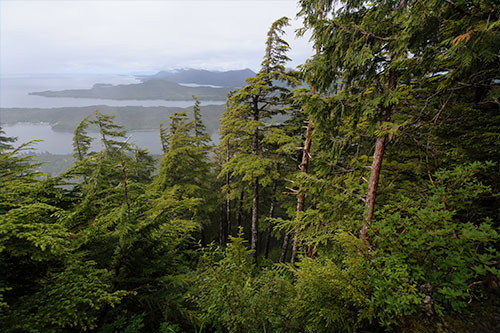
In the Face of Political Uncertainty, Tongass Transition Collaborative Stress Importance of Local Partnerships
December 27, 2017
According to the Tongass Transition Collaborative charter, this is a diverse group of stakeholders who are concerned with management of the Tongass National Forest. They have come together to help achieve a successful transition to primarily young growth forest based management. To achieve Secretary Vilsack’s July 2,2013 memorandum 1044-099 to “speed the transition away from old-growth timber harvesting and towards a forest industry that utilizes second growth... in a way that preserves a viable timber industry that provides jobs and opportunities for residents of Southeast Alaska."
According a TCC news release, at the national-level, the Secretary of the U.S. Department of Agriculture and the Chief of the USFS have recognized the importance of identifying opportunities for collective action through partnerships and engagement with states, non-governmental organizations, Native villages, and local citizens that share a vision of healthy forests and communities. To achieve this vision, those attending the meeting acknowledged, it will be necessary to work effectively with partners to promote a sense of shared stewardship and responsibility. Regional Forester, Beth Pendleton, emphasized alignment with these objectives for the Alaska Region of the USFS: “There is a growing focus in the Region to achieve common goals related to all parts of the [USFS] mission…not just on the National Forest, but with programs that serve the entire state, including forest health, the cooperative fire [management] program, and state and private forestry.” On the Tongass National Forest, the Tongass Transition Collaborative members stated significant progress has been made due to this collaborative approach to management. Building on consensus recommendations put forward by the multi-stakeholder Tongass Advisory Committee (TAC), partnerships have emerged with the USFS, State of Alaska Divisions of Forestry and Economic Development, the Alaska Forestry Association, conservation organizations, Sealaska Timber, and University of Alaska Trust Lands, among many others. Quoting the Tongass Transition Collaborative news release, these partnerships have resulted in successful implementation of robust forest inventory and data collection for over twenty thousand acres of young growth, workforce development training, seasonal and permanent employment opportunities for local residents, coordinated timber sale planning between multiple landowners in the region, and a Good Neighbor Authority timber sale that will provide 29 million board feet of young growth timber with a portion of proceeds benefiting habitat restoration on the Forest. The Tongass Transition Collaborative members said these actions represent an important shift in the culture of conflict surrounding Tongass forest management to one that embraces solutions that are inclusive of diverse viewpoints and seek opportunities for effective, efficient implementation of management decisions. During a round of reflections at the meeting, Forest Supervisor Earl Stewart reflected on how the situation has shifted over the past five-ten years, and the opportunity to build on the progress that has been made. He left the group with a challenge: “Do not fail to recognize that the table could be much larger, the issues we take on could be much larger, and the opportunities for Southeast Alaska could be much more lasting.” Faced with uncertainty surrounding national-level decisions, Tongass Transition Collaborative members stressed the necessity of continued local collaboration and problem-solving by individuals representing diverse interests. Co-chair Les Cronk thoughtfully stated, “I believe in the process, and continuing to work together is the right thing to do. Keeping the spirit of what the TAC achieved is essential – we need to keep moving forward and make adjustments as needed.” Others attending the meeting echoed his sentiment by acknowledging that long-term sustainability is created through implementation of collaborative place-based solutions. Looking toward the future, Tongass Transition Collaborative members said they see a continued role in supporting the USFS to do a better job to achieve its multiple-use mandate in a way that benefits individuals and organizations in the surrounding communities and Native villages of Southeast Alaska. Regional Forester Pendleton concluded the meeting with a sense of hope that such support will continue. She said, “We have the aptitude and will to move forward because of the relationships and trust that we have… This group is founded on learning and adaptation – I am confident that we can make those adaptations if we put our heads together to do what is right.” The Tongass Transition Collaborative (TTC) is a voluntary, grassroots initiative, and is not managed or controlled by the Forest Service or by any one entity. This is not the Tongass Advisory Committee which completed its final recommendations in December 2015,
Related: Download the December 14 TTC Meeting Agenda and Participant List Editing by Mary Kauffman, SitNews
Source of News:
Representations of fact and opinions in comments posted are solely those of the individual posters and do not represent the opinions of Sitnews.
|
|||
